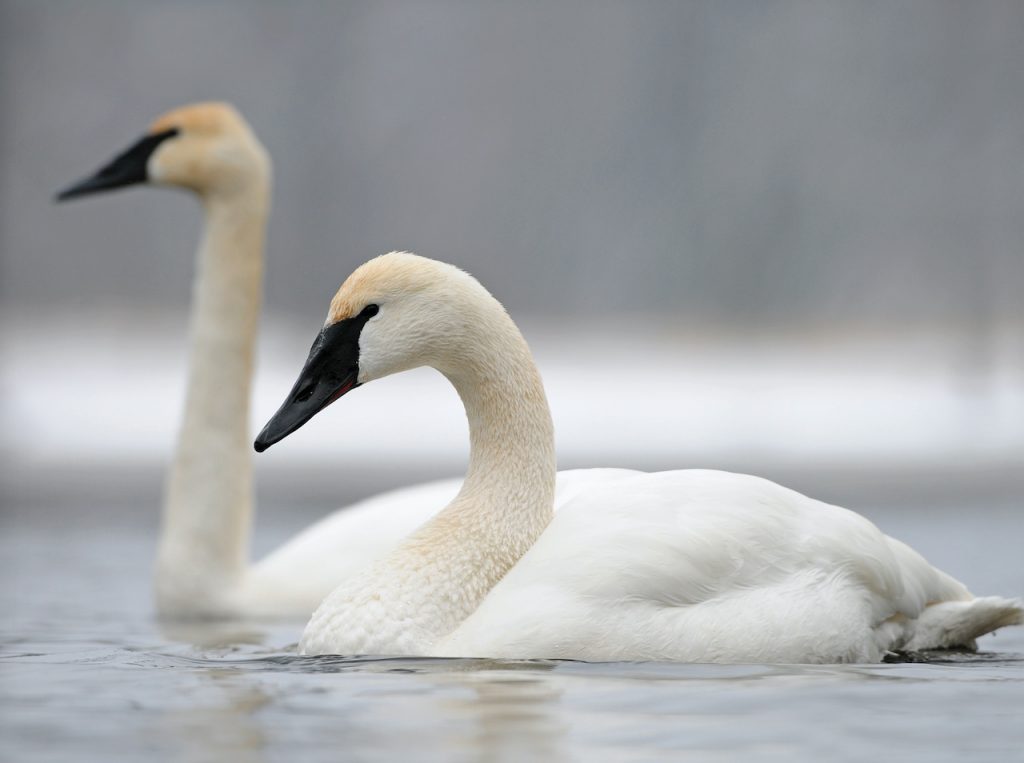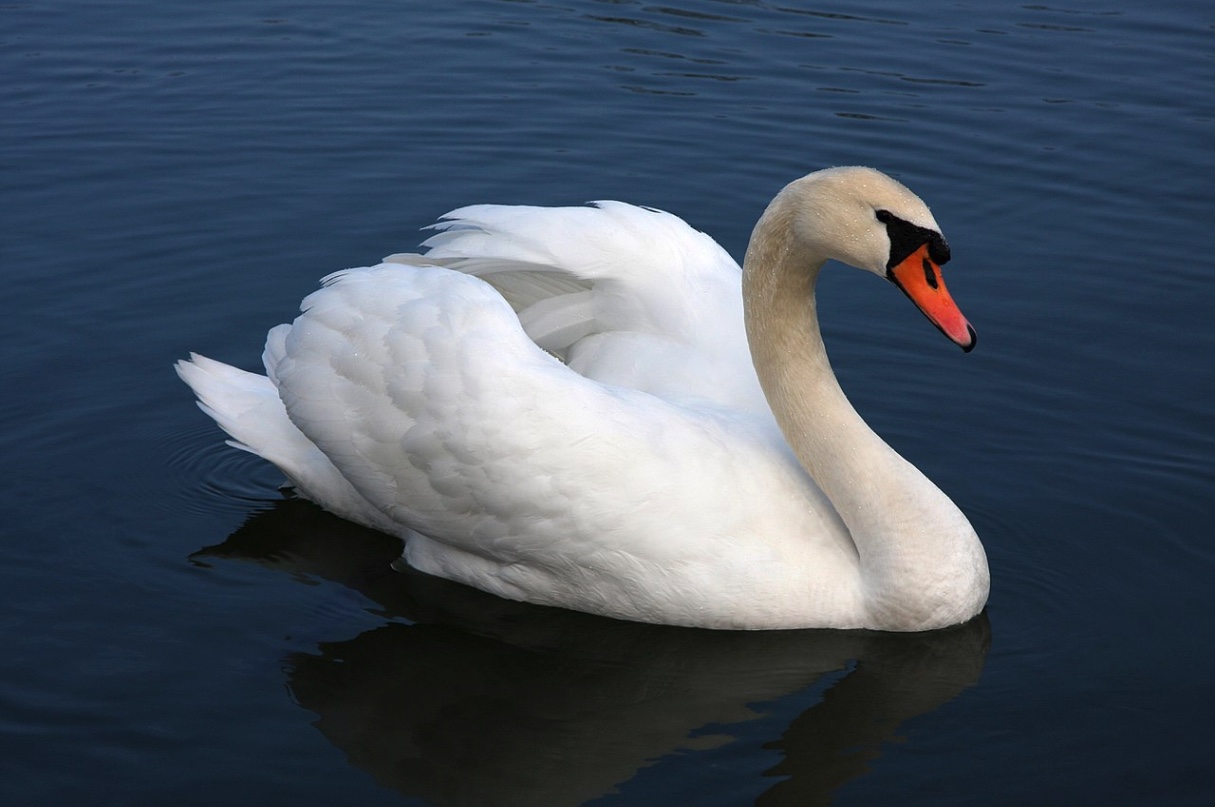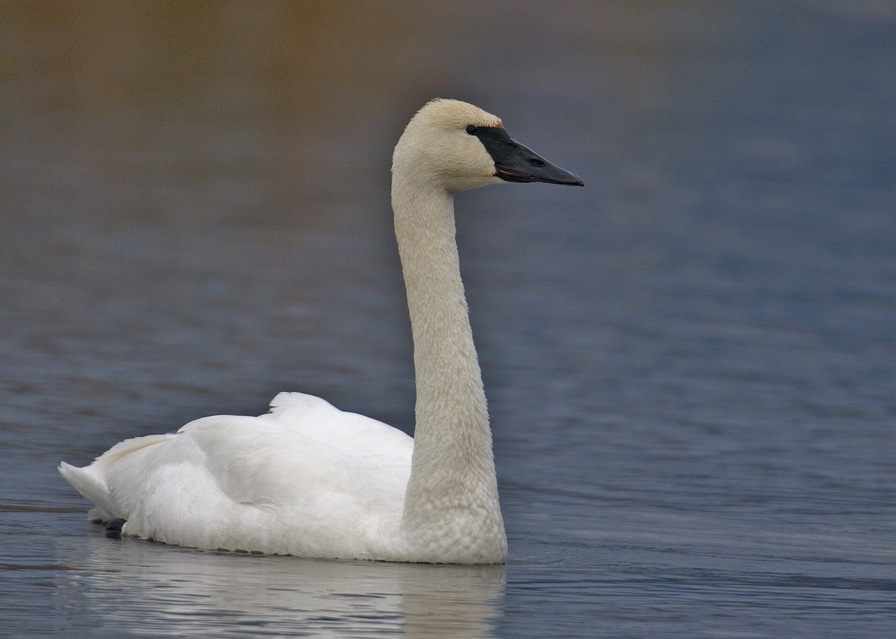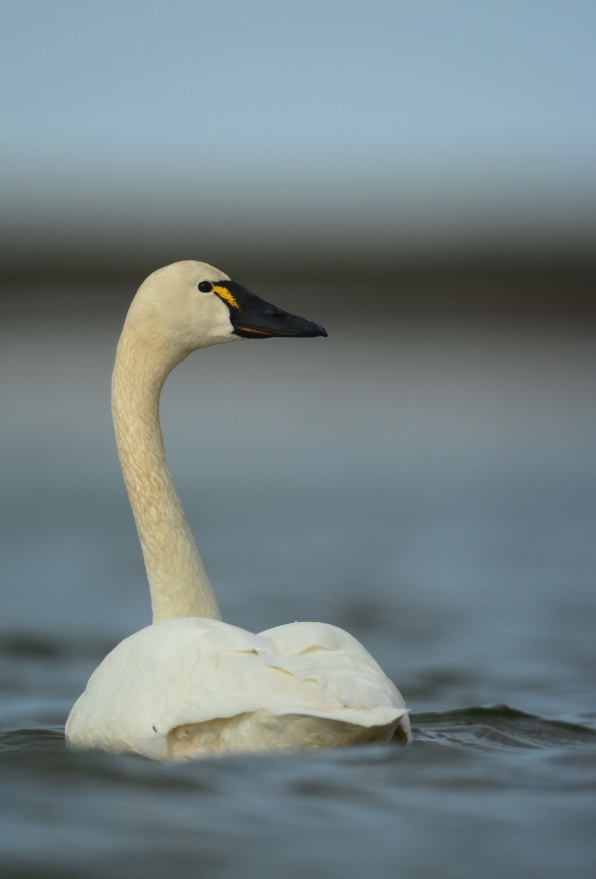
Photo: Ryan Askren
Mute Swan (Cygnus olor): The mute swan is not native to Illinois. They are large white birds, with males weighing 20 to 25 pounds and females weighing 16 to 20 pounds. The adults are easily identified by their orange bills with a black knob at the base. Mute swans have an S-shape to their necks and tend to hold their wings up and slightly out from their bodies while swimming. Juveniles can have gray or white feathers, and their bills are gray, pinkish, and then orange as the birds mature.
Trumpeter swan (Cygnus buccinator): Trumpeter swan populations declined dramatically during settlement, and they were extirpated from Illinois by 1900. Under Endangered Species Act protection and following reintroduction efforts, these swans are once again becoming abundant and are recolonizing their historic breeding range. Several records of breeding trumpeter swans have occurred in Illinois in recent years, with more discovered each year. Direct competition for breeding sites with nonnative mute swans is thought to be limiting the expansion of trumpeter swan populations in several Midwestern states, including Illinois.
The trumpeter swan is the largest native swan. These large white birds are the heaviest fliers, with adult males weighing more than 25 pounds. They tend to swim and fly with their necks held straight. They have black, wedge-shaped bills and black legs. Juveniles are gray with white highlights, and their black bills have a pink center.
Tundra Swan (Cygnus columbianus): Tundra swans are smaller than trumpeter or mute swans, weighing around 15 pounds. They have white feathers with black bills and feet. They have a spot of yellow on their face between their eyes and bill. Juveniles are tinged with gray on their feathers.
Introducing mute swans to an area to help control Canada geese numbers is not recommended. While mute swans will aggressively defend their nest sites during the spring breeding season and may harass nearby Canada geese, this is not a strong, year-round goose management strategy. During other times of the year mute swans are less aggressive towards other waterfowl. In fact, they are often seen using the same waterbodies as Canada geese. Their presence may even attract Canada geese in some areas.
Mute swans are not native to Illinois, they produce a lot of fecal matter, and their foraging habits can severely damage aquatic plants and habitats. Because their diet is similar to those of our native waterfowl, they often outcompete the native ducks, geese, and swans because of their size and feeding habits. For all of these reasons, the use of mute swans as a goose deterrent is strongly discouraged.
Other species of swans in Illinois are protected and may not be moved.
Mute swan: Native to Eurasia, mute swans were introduced to northeastern states in the late 1800s and early 1900s. They have since expanded their range to several eastern and midwestern states as well as portions of the western U.S. and Canada. In areas where they are found in Illinois, they are often year-round residents. They can be locally common.
Trumpeter swan: These birds migrate through Illinois from mid-October through mid-April.
Tundra swan: These are arctic birds that migrate through northern Illinois from February to mid-April and from late October to early December.
All three species of swans forage in fairly shallow water and will tip up like dabbling ducks, with their heads underwater to reach plants below the surface of the water. Both trumpeter and tundra swans swim with their necks straight, while the mute swan swims with their necks curved like an “S.”
Mute swans are more aggressive towards other swans, geese and ducks than the other two species of swans found in Illinois. They are also more aggressive towards people during the breeding season and may seasonally impact recreational areas used for swimming, fishing, or boating.
None of the swan species is considered a public health concern. However, mute swans can be extremely aggressive when protecting their active nests, and they have injured people in Illinois. Avoid approaching their nests.
Swans can leave excessive amounts of feces, which can negatively impact water quality and the land around ponds and lakes. Diseases that may potentially be transmitted to people through contact with mute swan feces include swimmer’s itch, salmonellosis, and E. coli infections.
While the number of swan–airplane strikes is very limited, they can do severe damage to aircraft due to their size.
Mute swan: They are often found in city parks, rivers, lakes. and ponds. They eat aquatic vegetation.
Trumpeter swan: These swans prefer open habitats near shallow bodies of water. Trumpeter swans can be found on large lakes and rivers but will sometimes forage in agriculture fields.
Tundra swan: They can be found on coastal waters and some inland lakes or in agriculture fields when they migrate through Illinois.
Mute swan: These birds breed in northern Illinois and locations throughout west-central Illinois. Mute swans aggressively defend their nests and can cause injury to people who venture too close.
Trumpeter swan: Although trumpeter swan populations had been extirpated from Illinois by 1900, under Endangered Species Act protection and following reintroduction efforts, these swans are once again becoming abundant. Several records of breeding trumpeter swans have occurred in Illinois in recent years, with more discovered each year. Direct competition for breeding sites with nonnative mute swans is thought to be limiting trumpeter swan population expansion in several Midwestern states, including Illinois.
Tundra swan: Tundra swans do not breed in Illinois.
Mute swans are the swans most likely to cause issues in Illinois. In cases where their numbers need to be reduced, the USDA-APHIS-Wildlife Services has published a guide to assist people dealing with nuisance mute swans.
The mute swan is not protected by the Migratory Bird Treaty Act since it is not native to the United States. This species is currently protected under the Illinois Wildlife Code.
Trumpeter swans and tundra swans are protected by the Migratory Bird Treaty Act and the Illinois Wildlife Code.

Photo: Yerpo, GFDL & CC BY-SA 3.0


The Wildlife Illinois website was authorized by the Illinois Department of Natural Resources (IDNR) in partial fulfillment of project W-147-T. The website was developed by the National Great Rivers Research and Education Center, 2wav, and the IDNR in partnership with the United States Department of Agriculture Animal and Plant Health Inspection Service Wildlife Services and University of Illinois Extension to provide research-based information about how to coexist with Illinois wildlife.